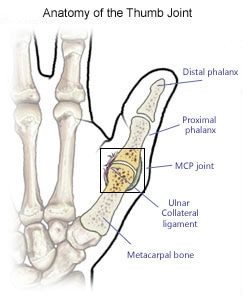Arthritis at the Base of the Thumb
Other names: Basal Joint arthritis, 1st CMC arthritis
 What is it?
What is it?
The thumb is made up of three highly mobile joints which allow for a high degree of motion. These joints are normally quite mobile and consist of the cartilage covered bone ends, allowing for shock absorption and smooth gliding coordinated movement. Over time, the cartilage can wear down in these joints, causing a painful gliding surface and less shock absorption, creating a condition commonly known as arthritis. The most common joint in to wear down in the hand is the highly mobile joint at the base of the thumb known as the thumb basal joint, other wise known as the carpometacarpal (CMC) joint. (see figure) You can feel for pain in this joint by palpating it in the fleshy part of the thumb side of the palm, about a centimeter above the wrist joint.
Who gets it?
The common causes for arthritis at the base of the thumb include age, female gender, joint laxity and previous injury to the joint. Genetics probably has the greatest influence on the condition as the exact cause is unknown.
This type of arthritis is generally called osteoarthritis, which is the progressive wearing down of a joint over time due to age. The other common form of arthritis is rheumatoid arthritis, which is an autoimmune inflammatory disease that rapidly destroys joints throughout the body.How do I know if I have it?Pain at the base of the thumb is the hallmark of the condition, though there are other conditions that can also cause similar symptoms which should be ruled out such as carpal tunnel syndrome or wrist arthritis. Pain occurs with pinching, grasping, buttoning buttons or opening a jar and eventually the destruction in the joint surfaces alters the thumb mechanics causing deformity and weakness.
To fully evaluate the joint, routine x-rays are helpful in identifying the condition and quantifying the amount of joint destruction.
What can be done to treat the arthritis at the base of the thumb?
First, this is a common condition and should be generally considered a normal part of the aging process. In addition, there are no cures for this this type of arthritis (osteoarthritis) so treatments are generally aimed at symptom relief and functional recovery. Perhaps someday we will have treatments that can address the cause of this arthritis.
Many people with this form of arthritis need no treatment as the symptoms remain tolerable. Often anti-inflamatory medication such as ibuprofen or Tylenol can decrease symptoms to a tolerable level, especially before significant activity. Thumb splints are also helpful in immobilizing the joint while allowing hand motion. These can be custom made by a hand therapist for optimal fit and function. Some patients find relief with steroid injections into the joint, which can be repeated up to 3 times a year for symptomatic treatment. Eventually, some patients continue to have pain and elect to proceed to surgical management which consists of removing the offending joint and reconstructing the thumb ligaments to eliminate the bone-on-bone pain and restore function.
